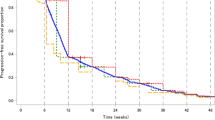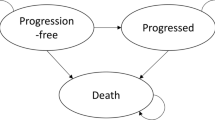Abstract
Models for situations where some individuals are long-term survivors, immune or non-susceptible to the event of interest, are extensively studied in biomedical research. Fitting a regression can be problematic in situations involving small sample sizes with high censoring rate, since the maximum likelihood estimates of some coefficients may be infinity. This phenomenon is called monotone likelihood, and it occurs in the presence of many categorical covariates, especially when one covariate level is not associated with any failure (in survival analysis) or when a categorical covariate perfectly predicts a binary response (in the logistic regression). A well known solution is an adaptation of the Firth method, originally created to reduce the estimation bias. The method provides a finite estimate by penalizing the likelihood function. Bias correction in the mixture cure model is a topic rarely discussed in the literature and it configures a central contribution of this work. In order to handle this point in such context, we propose to derive the adjusted score function based on the Firth method. An extensive Monte Carlo simulation study indicates good inference performance for the penalized maximum likelihood estimates. The analysis is illustrated through a real application involving patients with melanoma assisted at the Hospital das Clínicas/UFMG in Brazil. This is a relatively novel data set affected by the monotone likelihood issue and containing cured individuals.






Similar content being viewed by others
Data availibility statement
The data that support the findings of this study are available from the corresponding author upon reasonable request.
References
Achcar JA, Coelho-Barros EA, Mazucheli J (2012) Cure fraction models using mixture and non-mixture models. Math Publ 51(1):1–9
Albert A, Anderson JA (1984) On the existence of maximum likelihood estimates in logistic regression models. Biometrics 71(1):1–10
Almeida FM, Colosimo EA, Mayrink VD (2018) Prior specifications to handle the monotone likelihood problem in the Cox regression model. Stat Interface 11(4):687–698
Andersen PK (1991) Survival analysis 1982–1991: the second decade of the proportional hazards regression model. Stat Med 10(12):1931–1941
Arce PM, Camilon PR, Stokes WA, Nguyen SA, Lentsch EJ (2014) Is sex an independent prognostic factor in cutaneous head and neck melanoma? Laryngoscope 124(6):1363–1367
Ash RB, Doleans-Dade CA (2000) Probability and measure theory. Academic Press, San Diego
Berkson J, Gage RP (1952) Survival curve for cancer patients following treatment. J Am Stat Assoc 47(259):501–515
Boag JW (1949) Maximum likelihood estimates of the proportion of patients cured by cancer therapy. J R Stat Soc Ser B 11(1):15–53
Bryson MC, Johnson ME (1981) The incidence of monotone likelihood in the Cox model. Technometrics 23(4):381–383
Cai C, Zou Y, Peng Y, Zhang J (2012) smcure: an R-package for estimating semiparametric mixture cure models. Comput Methods Programs Biomed 108(3):1255–1260
Cherobin ACFP, Wainstein AJA, Colosimo EA, Goulart EMA, Bittencourt FV (2018) Prognostic factors for metastasis in cutaneous melanoma. Anais Brasileiros de Dermatologia 93(1):19–26
Damato B, Eleuteri A, Taktak AF, Coupland SE (2011) Estimating prognosis for survival after treatment of choroidal melanoma. Prog Retin Eye Res 30(5):285–295
Dempster AP, Laird NM, Rubin DB (1977) Maximum likelihood from incomplete data via the EM algorithm. J R Stat Soc Ser B 39(1):1–22
Elgmati E, Fiaccone RL, Henderson R, Matthews JN (2015) Penalised logistic regression and dynamic prediction for discrete-time recurrent event data. Lifetime Data Anal 21(4):542–560
Fang HB, Li G, Sun J (2005) Maximum likelihood estimation in a semiparametric logistic/proportional-hazards mixture model. Scand J Stat 32(1):59–75
Farewell VT (1982) The use of mixture models for the analysis of survival data with long-term survivors. Biometrics 38(4):1041–1046
Farewell VT (1986) Mixture models in survival analysis: Are they worth the risk? Can J Stat 14(3):257–262
Fijorek K, Sokolowski A (2012) Separation-resistant and bias-reduced logistic regression: Statistica macro. J Stat Softw 47(1):1–12
Firth D (1992) Bias reduction, the Jeffreys prior and GLIM. In: Fahrmeir L, Francis B, Gilchrist R, Tutz G (eds) Advances in GLIM and statistical modelling: proceedings of the GLIM 92 conference. Springer, New York, pp 91–100
Firth D (1993) Bias reduction of maximum likelihood estimates. Biometrika 80(1):27–38
Givens GH, Hoeting JA (2013) Computational statistics, 2nd edn. Wiley, Hoboken
Greenland S, Mansournia MA (2015) Penalization, bias reduction, and default priors in logistic and related categorical and survival regressions. Stat Med 34(23):3133–3143
Gu Y, Sinha D, Banerjee S (2011) Analysis of cure rate survival data under proportional odds model. Lifetime Data Anal 17(1):123–134
Hanin L, Huang LS (2014) Identifiability of cure models revisited. J Multivar Anal 130:261–274
He Z, Emura T (2019) The COM-Poisson cure rate model for survival data-computational aspects. J Chin Stat Assoc 57(1):1–42
Heinze G, Ploner M (2003) Fixing the nonconvergence bug in logistic regression with SPLUS and SAS. Comput Methods Programs Biomed 71(2):181–187
Heinze G, Schemper M (2001) A solution to the problem of monotone likelihood in Cox regression. Biometrics 57(1):114–119
Heinze G, Schemper M (2002) A solution to the problem of separation in logistic regression. Stat Med 21(16):2409–2419
Ibrahim JG, Chen MH, Sinha D (2001) Bayesian survival analysis, 1st edn. Springer, New York
Jeffreys H (1946) An invariant form for the prior probability in estimation problems. Proc R Soc Lond Ser A 186(1007):453–461
Kaplan EL, Meier P (1958) Nonparametric estimation from incomplete observations. J Am Stat Assoc 53(282):457–481
Kenne-Pagui EC, Colosimo EA (2020) Adjusted score functions for monotone likelihood in the Cox regression model. Stat Med 39(10):1558–1572
Kenne-Pagui EC, Salvan A, Sartori N (2017) Median bias reduction of maximum likelihood estimates. Biometrika 104(4):923–938
Klein JP, Moeschberger ML (2006) Survival analysis: techniques for censored and truncated data. Springer, New York
Kosorok MR, Lee BL, Fine JP et al (2004) Robust inference for univariate proportional hazards frailty regression models. Ann Stat 32(4):1448–1491
Kuk AYC, Chen CH (1992) A mixture model combining logistic regression with proportional hazards regression. Biometrika 79(3):531–541
Lakhal-Chaieb L, Duchesne T (2017) Association measures for bivariate failure times in the presence of a cure fraction. Lifetime Data Anal 23(4):517–532
Li CS, Taylor JM, Sy JP (2001) Identifiability of cure models. Stat Probab Lett 54(4):389–395
Lima VM, Cribari-Neto F (2016) Penalized maximum likelihood estimation in the modified extended Weibull distribution. Commun Stat Simul Comput 48(2):334–349
Lin IF, Chang WP, Liao YN (2013) Shrinkage methods enhanced the accuracy of parameter estimation using Cox models with small number of events. J Clin Epidemiol 66(7):743–751
Liu M, Lu W, Shao Y (2006) Interval mapping of quantitative trait loci for time-to-event data with the proportional hazards mixture cure model. Biometrics 62(4):1053–1061
Liu Y, Hu T, Sun J (2017) Regression analysis of current status data in the presence of a cured subgroup and dependent censoring. Lifetime Data Anal 23(4):626–650
Losch A, Tempfer C, Kohlberger P, Joura EA, Denk M, Zajic B, Breitenecker G, Kainz C (1998) Prognostic value of cathepsin D expression and association with histomorphological subtypes in breast cancer. Br J Cancer 78(2):205–209
Louis TA (1982) Finding the observed information matrix when using the EM algorithm. J R Stat Soc Ser B 44(2):226–233
Lu W (2008) Maximum likelihood estimation in the proportional hazards cure model. Ann Inst Stat Math 60(3):545–574
Lu W (2010) Efficient estimation for an accelerated failure time model with a cure fraction. Statistica Sinica 20:661–674
Mao M, Wang JL (2010) Semiparametric efficient estimation for a class of generalized proportional odds cure models. J Am Stat Assoc 105(489):302–311
Masud A, Tu W, Yu Z (2018) Variable selection for mixture and promotion time cure rate models. Stat Methods Med Res 27(7):2185–2199
Murphy S, Rossini A, van der Vaart AW (1997) Maximum likelihood estimation in the proportional odds model. J Am Stat Assoc 92(439):968–976
Murphy SA et al (1994) Consistency in a proportional hazards model incorporating a random effect. Ann Stat 22(2):712–731
Nash JC (2014) Nonlinear parameter optimization using R tools, 1st edn. Wiley, Chichester
Peng Y, Dear KB (2000) A nonparametric mixture model for cure rate estimation. Biometrics 56(1):237–243
Peng Y, Dear KB, Denham J (1998) A generalized F mixture model for cure rate estimation. Stat Med 17(8):813–830
Pianto DM, Cribari-Neto F (2011) Dealing with monotone likelihood in a model for speckled data. Comput Stat Data Anal 55(3):1394–1409
Ploner M, Heinze G (2015) coxphf: Cox regression with Firth’s penalized likelihood. R Package Version 11
R Core Team (2020) R: a language and environment for statistical computing. R Foundation for Statistical Computing, Vienna, Austria, https://www.R-project.org/
Rainey C (2016) Dealing with separation in logistic regression models. Political Anal 24(3):339–355
Rizzo ML (2007) Statistical computing with R, 1st edn. Chapman and Hall/CRC, London
Scharfstein DO, Tsiatis AA, Gilbert PB (1998) Semiparametric efficient estimation in the generalized odds-rate class of regression models for right-censored time-to-event data. Lifetime Data Anal 4(4):355–391
Silvapulle MJ (1981) On the existence of maximum likelihood estimators for the binomial response models. J R Stat Soc Ser B 43(3):310–313
Swain KP, Grover G, Goel K (2016) Mixture and non-mixture cure fraction models based on generalized Gompertz distribution under Bayesian approach. Tatra Mt Math Publ 66(1):121–135. https://doi.org/10.1515/tmmp-2016-0025
Sy JP, Taylor JMG (2000) Estimation in a Cox proportional hazards cure model. Biometrics 56(1):227–236
Taylor JMG (1995) Semi-parametric estimation in failure time mixture models. Biometrics 51(3):899–907
Wu J, de Castro M, Schifano ED, Chen MH (2018) Assessing covariate effects using Jeffreys-type prior in the Cox model in the presence of a monotone partial likelihood. J Stat Theory Pract 12(1):23–41
Yakovlev AY, Tsodikov AD (1996) Stochastic models of tumor latency and their biostatistical applications, vol 1. World Scientific, Singapore. https://doi.org/10.1142/2420
Yamaguchi K (1992) Accelerated failure-time regression models with a regression model of surviving fraction: an application to the analysis of permanent employment in japan. J Am Stat Assoc 87(418):284–292
Yu B, Tiwari RC, Feuer EJ (2011) Estimating the personal cure rate of cancer patients using population-based grouped cancer survival data. Stat Methods Med Res 20(3):261–274
Zaeran E, Azizmohammad Looha M, Amini P, Azimi T, Mahmoudi M (2019) Evaluating long-term survival of patients with esophageal cancer using parametric non-mixture cure rate models. J Adv Med Biomed Res 27(120):43–50
Zorn C (2005) A solution to separation in binary response models. Political Anal 13(2):157–170
Acknowledgements
The authors would like to thank two anonymous referees for their constructive comments and suggestions leading to an improved version of this paper. The first author thanks Coordenação de Aperfeiçoamento de Pessoal de Nível Superior (CAPES, Brazil) for supporting his research. The second author acknowledge the support from Conselho Nacional de Desenvolvimento Científico e Tecnológico (CNPq, Brazil).
Author information
Authors and Affiliations
Corresponding author
Ethics declarations
Conclict of interest
The authors declare that they have no conflict of interest.
Additional information
Publisher's Note
Springer Nature remains neutral with regard to jurisdictional claims in published maps and institutional affiliations.
Electronic supplementary material
Below is the link to the electronic supplementary material.
Rights and permissions
About this article
Cite this article
Almeida, F.M., Colosimo, E.A. & Mayrink, V.D. Firth adjusted score function for monotone likelihood in the mixture cure fraction model. Lifetime Data Anal 27, 131–155 (2021). https://doi.org/10.1007/s10985-020-09510-4
Received:
Accepted:
Published:
Issue Date:
DOI: https://doi.org/10.1007/s10985-020-09510-4




